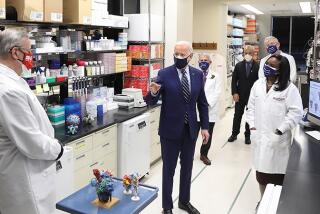Techniclone Interim President Made Permanent
- Share via
The run-up in biotechnology stocks during the first three months this year saved tiny Techniclone Corp. from the brink of oblivion. Shares that were trading at 25 cents in December hit $16.63 during trading in March.
But as Techniclone stock has since plummeted--along with a general drop in biotech stocks--the future is a bit more complicated for the Tustin developer of cancer treatments.
John Bonfiglio, though, isn’t letting the market hamper him too much as he continues to downsize and refocus the company. Bonfiglio, brought in as interim president in a shake-up last fall, was named Tuesday as the company’s full-time president and chief executive.
“We’re going to have to ride the ups and downs of the market,” he said Tuesday after the company’s stock lost 3 cents in trading to close at $2.53 a share.
Bonfiglio figures that the best way to improve shareholder value is to show investors that the company’s products are real. So he’s striking licensing deals to get Techniclone technology out in the industry and generate revenue.
“The big payoff is getting a commercial product out there, and that’s what we’re striving to do,” he said.
Bonfiglio joined Techniclone in 1997 as vice president of business development. The company on Tuesday also promoted Steve King to vice president, technology and product development, and Paul Lytle to vice president, finance.
With Bonfiglio on board, the company’s strategy has changed, said Edward Legere, a Techniclone director and the company’s largest shareholder. “He’s done quite a good job in helping turn this thing around,” Legere said.
In the past, Techniclone focused on wanting to become a manufacturer of antibodies--akin to smart biological missiles--that seek cancer cells and destroy them.
Now the company is focusing on getting those therapies, primarily four that target various types of cancers, through the process of clinical trials and government approvals as commercial products.
Cotara, for instance, is in the second phase of clinical trials as a drug to fight brain cancer. Legere said it should hit the market in two years if research proves successful.
A clinical focus will bring to the company what it had lacked for years, Legere said, and will give investors what they have wanted to see: results.
Even though the anti-cancer therapies are in early-phase clinical trials and won’t lead to any sales in the near future, Bonfiglio hopes that the promise of a concrete product in the pipeline will keep the stock price up.
Meantime, several licensing deals might raise some revenue soon, Bonfiglio said.
In mid-May, the company formed a joint venture with OxiGene Inc. to merge the cancer-fighting technologies of the two companies. And Techniclone has licensed its Oncolym, a drug to treat non-Hodgkin’s lymphoma, to Schering AG.
Techniclone has drawn down $12 million of its $20-million equity line of credit to fund its operations, and can continue to draw against it as long as the stock price remains above $1 a share.
Under an equity line of credit, a research and development company like Techniclone sells shares at lower-than-market prices to a financing company, which can reap its profit by selling the shares at market value.
As the company gets closer to creating a product, Bonfiglio said, it may then seek a round of private funding or perhaps even a secondary offering.
He said the company, which has reduced staff from 45 to 18 employees and taken other cost-cutting measures, has enough cash to make it through the next 12 months.
Referring to the money needed for the clinical trials, he said: “We want to burn money in things that will make us successful.”
(BEGIN TEXT OF INFOBOX / INFOGRAPHIC)
Sliding Stock
Shares of Techniclone Corp., mired in the penny-stock range--literally--in December, soared early this year until the big March sell-off in technology and bio-tech stocks began. Here are the closing prices year to date:
Close: $2.53
More to Read
Inside the business of entertainment
The Wide Shot brings you news, analysis and insights on everything from streaming wars to production — and what it all means for the future.
You may occasionally receive promotional content from the Los Angeles Times.










